 |
 |
Our enthusiastic and extremely knowledgeable perennials team is here to answer your questions and help you choose the best perennials for your situation. There’s always something in bloom for sun, shade, butterflies, birds or deer resistance as well as a variety of bulbs for your space.
Stroll through our time-tested favorites and introduce yourself to the newest varieties. We garden with perennials too; we love them and it shows!
|
18 found, showing page 1 of 2

Plant Height: 12 inches
Flower Height: 18 inches
Spacing: 18 inches
Sunlight: partial shade full shade
Hardiness Zone: 2b
Other Names: False Spirea
Description:
An upright-mounded, low maintenance and shade loving variety; pure white plumes rise above mounds of ferny foliage; an excellent addition to shaded gardens, borders, containers or moon gardens; low maintenance
Ornamental Features:
Bridal Veil Astilbe has masses of beautiful plumes of white flowers at the ends of the stems from late spring to early summer, which are most effective when planted in groupings. The flowers are excellent for cutting. Its ferny compound leaves remain emerald green in color throughout the season.
Landscape Attributes:
Bridal Veil Astilbe is an herbaceous perennial with an upright spreading habit of growth. Its relatively fine texture sets it apart from other garden plants with less refined foliage.
This is a relatively low maintenance plant, and is best cleaned up in early spring before it resumes active growth for the season. It is a good choice for attracting butterflies to your yard, but is not particularly attractive to deer who tend to leave it alone in favor of tastier treats. It has no significant negative characteristics.
Bridal Veil Astilbe is recommended for the following landscape applications:
- Mass Planting
- Rock/Alpine Gardens
- Border Edging
- General Garden Use
- Container Planting
- Planting & Growing
Bridal Veil Astilbe will grow to be about 12 inches tall at maturity extending to 18 inches tall with the flowers, with a spread of 24 inches. When grown in masses or used as a bedding plant, individual plants should be spaced approximately 18 inches apart. Its foliage tends to remain dense right to the ground, not requiring facer plants in front. It grows at a medium rate, and under ideal conditions can be expected to live for approximately 10 years. As an herbaceous perennial, this plant will usually die back to the crown each winter, and will regrow from the base each spring. Be careful not to disturb the crown in late winter when it may not be readily seen!
This plant does best in partial shade to shade. It requires an evenly moist well-drained soil for optimal growth. It is very fussy about its soil conditions and must have rich, acidic soils to ensure success, and is subject to chlorosis (yellowing) of the foliage in alkaline soils. It is somewhat tolerant of urban pollution, and will benefit from being planted in a relatively sheltered location. Consider applying a thick mulch around the root zone over the growing season to conserve soil moisture. This particular variety is an interspecific hybrid. It can be propagated by division; however, as a cultivated variety, be aware that it may be subject to certain restrictions or prohibitions on propagation.
Bridal Veil Astilbe is a fine choice for the garden, but it is also a good selection for planting in outdoor pots and containers. It is often used as a 'filler' in the 'spiller-thriller-filler' container combination, providing a mass of flowers against which the larger thriller plants stand out. Note that when growing plants in outdoor containers and baskets, they may require more frequent waterings than they would in the yard or garden.
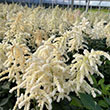
Soft, feathery, white flower heads bloom through the summer. Deer and rabbit resistant. USDA 4-9
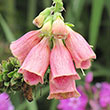
Deep pink blooms on spires. Perennial hybrid. Toxic. USDA 4-8
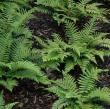
Height: 32 inches
Spacing: 30 inches
Sunlight: partial shade, full shade
Hardiness Zone: 5b
Other Names: Korean Tassle Fern
Description:
A stunning fern for the shade garden with bright green new fronds that turn darker when mature; after they unwind, the tips hang down, like a tassel, but eventually straighten out; cut fronds are great for flower arrangements
Ornamental Features:
Japanese Tassel Fern is primarily valued in the garden for its cascading habit of growth. Its ferny pinnately compound leaves emerge light green in spring, turning forest green in color the rest of the year.
Landscape Attributes:
Japanese Tassel Fern is an herbaceous evergreen fern with a shapely form and gracefully arching fronds. Its relatively fine texture sets it apart from other garden plants with less refined foliage.
This is a relatively low maintenance plant, and is best cleaned up in early spring before it resumes active growth for the season. Deer don't particularly care for this plant and will usually leave it alone in favor of tastier treats. It has no significant negative characteristics.
Japanese Tassel Fern is recommended for the following landscape applications:
- Mass Planting
- General Garden Use
- Groundcover
- Naturalizing And Woodland Gardens
Planting & Growing:
Japanese Tassel Fern will grow to be about 32 inches tall at maturity, with a spread of 3 feet. When grown in masses or used as a bedding plant, individual plants should be spaced approximately 30 inches apart. Its foliage tends to remain dense right to the ground, not requiring facer plants in front. It grows at a medium rate, and under ideal conditions can be expected to live for approximately 15 years. As an evegreen perennial, this plant will typically keep its form and foliage year-round.
This plant does best in partial shade to shade. It requires an evenly moist well-drained soil for optimal growth, but will die in standing water. It is not particular as to soil pH, but grows best in rich soils. It is somewhat tolerant of urban pollution, and will benefit from being planted in a relatively sheltered location. Consider applying a thick mulch around the root zone over the growing season to conserve soil moisture. This species is not originally from North America, and parts of it are known to be toxic to humans and animals, so care should be exercised in planting it around children and pets. It can be propagated by division.

2-3 foot leathery fronds stay green all winter, giving it its name. Silvery fiddleheads emerge in early spring. USDA 3-9
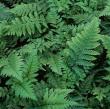
Grayish-green, deeply cut, leathery fronds. Easily grown in average, medium, well-drained soil. USDA 3-8
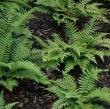
Outward spreading fronds. Evergreen. Requires good Drainage. USDA 5-8

2?3 foot leathery fronds stay green all winter, giving it its name. Silvery fiddleheads emerge in early spring. USDA 3-9
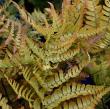
Height: 18 inches
Spread: 18 inches
Sunlight: partial shade, full shade
Hardiness Zone: 4b
Other Names: Japanese Red Shield Fern
Description:
Lovely deep green fronds; fiddleheads and fronds emerge copper colored; great woodland and shade garden plant; keep evenly moist
Ornamental Features:
Brilliance Autumn Fern is primarily valued in the garden for its cascading habit of growth. Its attractive glossy ferny compound leaves emerge coral-pink in spring, turning forest green in color with prominent coppery-bronze tips the rest of the year.
Landscape Attributes:
Brilliance Autumn Fern is a dense herbaceous evergreen fern with a shapely form and gracefully arching fronds. It brings an extremely fine and delicate texture to the garden composition and should be used to full effect.
This is a relatively low maintenance plant, and should be cut back in late fall in preparation for winter. Deer don't particularly care for this plant and will usually leave it alone in favor of tastier treats. It has no significant negative characteristics.
Brilliance Autumn Fern is recommended for the following landscape applications:
- Mass Planting
- Rock/Alpine Gardens
- Border Edging
- General Garden Use
- Groundcover
- Naturalizing And Woodland Gardens
Planting & Growing:
Brilliance Autumn Fern will grow to be about 18 inches tall at maturity, with a spread of 18 inches. Its foliage tends to remain dense right to the ground, not requiring facer plants in front. It grows at a medium rate, and under ideal conditions can be expected to live for approximately 15 years. As an evegreen perennial, this plant will typically keep its form and foliage year-round.
This plant does best in partial shade to shade. It is quite adaptable, prefering to grow in average to wet conditions, and will even tolerate some standing water. It is particular about its soil conditions, with a strong preference for rich, acidic soils. It is somewhat tolerant of urban pollution, and will benefit from being planted in a relatively sheltered location. Consider applying a thick mulch around the root zone over the growing season to conserve soil moisture.
This is a selected variety of a species not originally from North America, and parts of it are known to be toxic to humans and animals, so care should be exercised in planting it around children and pets. It can be propagated by division; however, as a cultivated variety, be aware that it may be subject to certain restrictions or prohibitions on propagation.
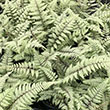
Upright silvery foliage. Maroon midribs. Tolerates seep shade. USDA 4-8
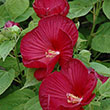
8" deep red blooms. Compact habit. Tolerates wet sites. USDA 5-9
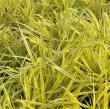
Golden Hakone Grass | Gracefully arching green leaves variegated with gold striping. Yellow-green flowers appear in loose, nodding panicles in mid-summer. Naturalizing. USDA 5-9

Dense, clumping, variegated foliage. Low-maintenance. USDA 5-9
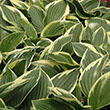
Dark green foliage framed in gold. Lavender blooms. USDA 3-9
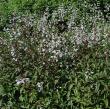
Plant Height: 18 inches
Flower Height: 30 inches
Spacing: 18 inches
Sunlight: full sun partial shade
Hardiness Zone: 3b
Other Names: Beardtongue
Ornamental Features:
Husker Red Beard Tongue has masses of beautiful spikes of white tubular flowers rising above the foliage from early to mid summer, which are most effective when planted in groupings. The flowers are excellent for cutting. Its attractive narrow leaves emerge burgundy in spring, turning dark green in color with distinctive deep purple edges throughout the season. The deep purple stems are very colorful and add to the overall interest of the
plant.
Landscape Attributes:
Husker Red Beard Tongue is an herbaceous perennial with an upright spreading habit of growth. Its medium texture blends into the garden, but can always be balanced by a couple of finer or coarser plants for an effective composition.
This is a relatively low maintenance plant, and is best cleaned up in early spring before it resumes active growth for the season. It is a good choice for attracting butterflies and hummingbirds to your yard. It has no significant negative characteristics.
Husker Red Beard Tongue is recommended for the following landscape applications:
- Mass Planting
- Border Edging
- General Garden Use
- Container Planting
Planting & Growing:
Husker Red Beard Tongue will grow to be about 18 inches tall at maturity extending to 30 inches tall with the flowers, with a spread of 24 inches. When grown in masses or used as a bedding plant, individual plants should be spaced approximately 18 inches apart. It grows at a fast rate, and under ideal conditions can be expected to live for approximately 10 years. As an herbaceous perennial, this plant will usually die back to the crown each winter, and will regrow from the base each spring. Be careful not to disturb the crown in late winter when it may not be readily seen!
This plant does best in full sun to partial shade. It prefers dry to average moisture levels with very well-drained soil, and will often die in standing water. It is considered to be drought-tolerant, and thus makes an ideal choice for a low-water garden or xeriscape application. It is not particular as to soil type or pH. It is somewhat tolerant of urban pollution. This is a selection of a native North American species. It can be propagated by cuttings; however, as a cultivated variety, be aware that it may be subject to certain restrictions or prohibitions on propagation.
Husker Red Beard Tongue is a fine choice for the garden, but it is also a good selection for planting in outdoor pots and containers. With its upright habit of growth, it is best suited for use as a 'thriller' in the 'spiller-thriller-filler' container combination; plant it near the center of the pot, surrounded by smaller plants and those that spill over the edges. Note that when growing plants in outdoor containers and baskets, they may require more frequent waterings than they would in the yard or garden.
18 found, showing page 1 of 2









